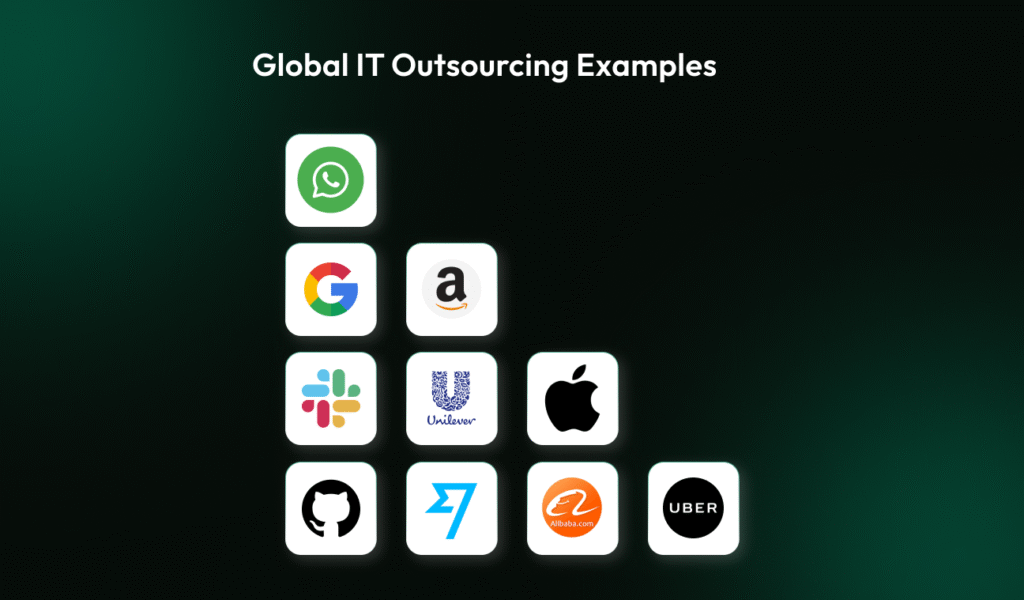

Key Takeaways
- The worldwide IT outsourcing market will grow to $651 billion in the year 2025, continuing to show growth each year.
- Outsourcing can reduce software development costs, on average, up to 60% compared to Western labor rates.
- Companies such as Apple, Google, and WhatsApp capitalized on employing global talent when developing successful mobile applications.
- When you hire full-stack developers, it can accelerate product launches.
- Enterprise software solutions increasingly advance when using AI-based solutions and class-A software developers.
Introduction
The global IT outsourcing market was of $744 million in 2024 and is projected to exceed $1219 billion by 2030. This illustrates that major technology companies continue to use outsourcing as a strategy for scale and innovation. In other words, both start-ups in Silicon Valley and corporations with worldwide operations are turning to software development firms located around the world for their cost efficiency, speed of development, and expertise.

Image Source: Projected IT Outsourcing Market Size by Region (2018 vs 2030)
According to statistics, 66% of companies in the U.S. outsource at least one business function. Roughly 36% of the global $500 billion outsourcing industry is from the Asia-Pacific region, which is powered by technology hubs in India, Vietnam, and the Philippines.
This region continues to grow and strengthen as a global outsourcing region until 2030. Software development and mobile app development are two of the most popular outsourcing categories, along with a growing demand for artificial intelligence-based solutions, as well as cybersecurity and enterprise software solutions.
Here, we are going to discuss some real-life outsourcing case studies from tech providers that have transformed their businesses with third-party professionals. We will share the reasons companies are hiring professional developers to help build and plan their products. Read on.
The Strategic Benefits of IT Outsourcing
The reason for IT outsourcing continues to change. It’s no longer just about reducing operational costs; today, IT leaders want operational flexibility, operational scale, and specialized expertise that only a global talent pool can provide.

- Access to expertise: Outsourcing provides access to hard-to-find skills, such as niche AI-developed solutions or advanced cybersecurity, through the use of established software development companies.
- Reduced risk: External contractors provide tested frameworks, which lowers the risk of errors in systems, delays, and compliance failures.
- Faster time to launch: Having the ability to “hire dedicated deliverers” or hire “full-stack developers” on-demand increases time to products and enables faster iterations in mobile app development and enterprise software solutions.
Cost and Performance Stats
- Outsourcing a software development job can cut costs by as much as 60% in high-cost labor markets (USA, Western Europe) compared to the expense of hiring on-site labor.
- According to Statista, the average spend on IT outsourcing per employee will rise to $156.92 by 2025, indicating that outsourcing is now on the path to becoming a normalized operational method of core business strategy.
- 72% of all global outsourcing is in IT and technical services; 60% of that is in application development.
Top 10 Global IT Outsourcing Examples
In the following section, we illustrate how ten tech giants used outsourcing to launch, scale, or re-invent a range of high-quality digital products and services. All the cases incorporate a different mix of categories (software development, mobile app development, etc., besides engendering AI-within-editing solutions and other enterprise software).

1. WhatsApp: Scaling with Outsourced Mobile App Development
WhatsApp’s rapid rise stemmed from having a dedicated core team that effectively outsourced a large portion of its iOS and web platform development. By hiring outsourced talent in offshore locations, an effective, stable messaging service was developed and launched at a pace that eventually garnered business from nearly 2 billion users around the world. Because WhatsApp was able to outsource, it was able to emphasize user experience and speed to market, paving the way for changes in digital communication experiences.
2. Google: Customer Support, Cloud Services and AI Solutions
Google utilizes a network of outsourced partners to manage customer support services (e.g., Google Ads). This empowers internal product development teams to innovate in product development while offshore partners manage technical assistance at a global scale. There have been over 120,000 outsourced workers who have partnered with Google providing support not just in support roles, but also in important early-stage functions of software development and even in AI solutions in some cases.
3. Uber: Supercharging Talent Selection
Uber outsourced sourcing and the recruitment of providers to fill over 200 technical and non-technical positions in less than a year. Banking on “hire dedicated deliverers” as well as recruitment process outsourcing, Uber was able to tap new markets and scale the onboarding process of employees ten times faster than they could have using internal employees.
4. Alibaba: Global Expansion through Software Development Companies
Alibaba’s initial site was constructed through a software agency in the U.S., giving it a basis in global usability and design. Since then, Alibaba has depended on Chinese and global partners for mobile app, payments, and cloud service development. The ability to “hire full-stack developers” on demand has allowed Alibaba to launch new products and break into global markets expeditiously.
5. Apple: Global Manufacturing and Component Outsourcing
Apple serves as an example of how a relentless focus on design and core innovation can be synchronized with outsourced manufacturing and component assembly. Outsourcing allowed Apple to ramp up manufacturing without sacrificing costs for history-making, large-scale launches like the iPhone and remain operationally competitive within the global arena.
6. Unilever: Enterprise Software Solutions for Global Efficiency
Unilever, which needed enterprise resource planning (ERP) systems integrated in multiple countries, outsourced data and enterprise software solutions to an IT partner that specializes in SAP and automated business process solutions. The result was an integrated approach to firm-wide operations around the globe without increasing internal human resource costs, a paradigm for other brands that operate on a multi-national level.
7. Slack: Outsourcing Product Design for User Experience
Prior to its public debut, Slack outsourced the development of its first application and web design to third-party professionals. The partnership with mobile app developers with design expertise turned its prototype and UX-focused ideas into a seamless and effective platform that millions of users depend on every day.
8. GitHub: Offshoring Development Talent to Scale Backend Effectively
Even at nearly 100 million users, GitHub outsourced its backend development to specialists to ensure optimised systems, which allowed the internal team to concentrate on new features and the community while outsourced companies made enhancement and optimization of critical systems and infrastructure.
9. TransferWise (Wise): Outsourced Front-End Development
TransferWise outsourced their front-end website development, improving usability while keeping pace with rapid global expansion, allowing the company to provide improvements to client experience, while internal developers focused on the financial and regulatory systems.
10. Amazon: Outsourced Logistics and Cloud or Multi-Channel Support
Because of its tremendous scale, without outsourcing logistics to expert logistics vendors, customer support, and cloud architecture management, Amazon would never have been able to reach the level of worldwide satisfaction with its customers. Dedicated outsourced teams effectively manage logistics operations, keeping deliveries fast and efficient and systems easily scalable.
Market Size
Recent predictions indicate that IT outsourcing in the Asia-Pacific area will grow to $238.3 billion in 2025 and more than double to $491.1 billion in 2034. Meanwhile, Europe will move from $588.38 billion in 2025 to $806.55 billion by 2030, furthering evidence that outsourcing is expanding steadily and globally.
How are AI-Driven Solutions Is Enhancing Outsourcing Success?
In recent years, there has been a significant increase in the outsourcing of AI-driven solutions (chatbots, predictive analytics, and cognitive automation). Many require particular knowledge, or “field of expertise,” which is typically best acquired through a partner organization/external provider.
- Full-stack developers provide good scalability for new product development and ease of deployment for enterprise software solutions.
- India continues to be the leading destination for outsourcing software development, accounting for 55% of the global market share and having an extensive background in both mobile app development and enterprise software solutions.
How to Choose the Right IT Outsourcing Model?
You have a few models to consider:
- Staff Augmentation: This means adding experienced external individuals to a team on-demand to fill skill gaps, and or when a client requests “dedicated deliverers” for an urgent deliverable.
- Dedicated Teams: a fully-private unit that works only for your project, this is typically preferred by clients looking for significant engagement over a longer duration.
- Project-based: Hire a software development company to produce one well-defined deliverable, an example of this is usually launching a mobile app.
Each model has various types of flexibility and cost structures. LL Technolab recommends starting with a pilot project, and then engaging your units phase by phase to define the model your company feels best aligns with your objectives.

Final Thoughts
The success of WhatsApp’s mobile app development and Google’s extensive use of outsourced tech teams demonstrates that the right strategy for outsourcing can lead to high-quality and scalable digital products. If you desire the advantages of robust software solutions, AI-led solutions, and top-tier delivery, partnering with a reliable provider of outsourcing services, like LL Technolab, offers a clear path to results.
Whether they are hiring dedicated deliverers, leveraging top-tier talent in full-stack developers, or developing next-generation mobile apps, software development companies are not just a vendor; they are a partner in growth for digital transformation for 2025 and beyond.
FAQs
Q1: What services do tech companies outsource the most?
Answer: Software development, mobile application development, customer support, artificial intelligence development solutions, and enterprise software development solutions are the main services that tech companies will outsource. The ability to quickly hire dedicated deliverers and full-stack developers helps promote speed and innovation.
Q2: How does outsourcing allow network providers to save money and provide quicker time to market?
A: Outsourcing to global talent pools can result in operational savings of approximately 60% compared to a company’s own in-house teams, and relying on external agencies also leads to time savings as the external agency generates its own talent as well as processes to complete work.
Q3: What are the risks involved and how do you reduce those?
A: The major risks are communication gaps, data security, and time zone friction. To address these potential risks, take time to evaluate the software development companies to partner with, use well-defined contracts to support the development team’s work and use regular oversight to complete the work.
